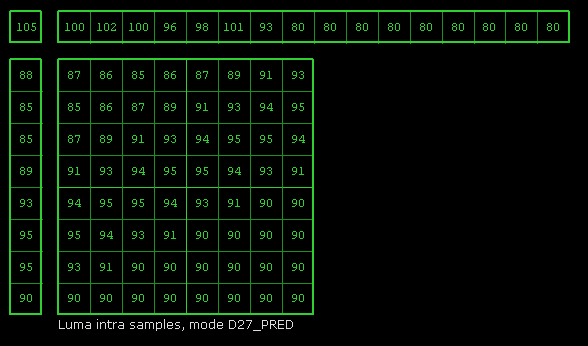近期 Google 已经开始研究 VP10 了,VP10 是一个由 WebM 和 Motroska 包含的开放、免费视频编解码器。Google 也已利用 VP10 来处理 YouTube 4K 视频。
目前互联网上使用最多的视频编码标准是 Google 研发、无版权费的 VP9。VP9 作为 VP8 的后继产品,主要竞争对手是 MPEG 的高效视频编码标准 HEVC。和 HEVC 相比,VP9 在网络浏览器中有更良好的支持性。它也以其优秀的视频编码质量和压缩效率而被广泛应用于互联网视频网站中。

从上图可以看出 Firefox、Chrome、Opera 等主流浏览器都支持。据统计,截止到 2017 年初,大约有 75% 的浏览器已经支持 VP9。
那么 VP9 是如何在原有的视频编码标准的基础上,提升视频编码质量和压缩效率的呢?
VP9 编码效率提高 50% 以上
VP9 是一种基于宏块的变换编码格式,与 HEVC 等视频编码标准相比,VP9 等比特流格式的视频编码标准相对简单。
与 VP8 相比,VP9 视频编码标准在技术上有许多优化:
-
支持使用 64×64 像素的编码单元,这在高分辨率视频中效果最为明显;
-
改善运动矢量的预测,除了 VP8 的四种模式(average/"DC"、 "true motion"、horizontal、vertical),VP9 还支持像素的线性外推的 6 个倾斜方向的帧内预测;
-
支持将帧分割为具有特定相似性的区域;
-
对运动矢量的第 8 像素精度、三种可切换的子像素插值滤波器、参考运动矢量、熵编码、环路滤波、ADST、DCT 等进行优化。
图片分区优化
VP9 将图片分成 64x64 大小的宏块 —— super blocks。super blocks 按照从左到右,从上到下的光栅顺序处理。同时与其他编解码器相同,super blocks 最小可以细分到 4x4 。细分宏块方式与 HEVC 一样通过递归四叉树编码结构完成,但是 VP9 支持水平或垂直细分。

此外,VP9 也支持拼贴,图片会被分解成沿着 super blocks 边界拼贴成网格。与 HEVC 不同的是,这些网格能均匀地分布,并且有两个幂数。网格的宽度 256 像素与 4096 像素之间。
比特流编码
VP9 使用 8 位算术编码引擎 bool-coder 压缩比特流。概率模型对整个帧是固定的,所有概率模型在帧数据开始解码之前都是已知的。这些概率模型存储在帧的上下文中,解码器维护在上下文中的四个概率模型。
每一帧编码组成:
-
未压缩的标题:十几个字节,包含像图片大小,循环过滤器强度等;
-
压缩标头:传输用于帧的 Bool 编码部分;
-
压缩帧数据(布尔编码数据):重建帧所需的数据,包含宏块分区大小,运动矢量,帧内模式和变换系数。
VP9 与 VP8 不同的是,不存在数据分区,所有数据类型以 super blocks 编码顺序交织。
帧内预测
VP9 中的帧内预测类似于 AVC / HEVC 的帧内预测,遵循变换宏块分区。因此帧内预测操作总是正方形的。比如说,具有 8×8 变换的 16×8 块会导致两次 8×8 亮度预测操作。
VP9 有 10 种不同的预测模式,其中 8 个预测模式是定向的。像其他编解码器一样,帧内预测需要两个 1D 阵列,其中包含相邻像素块重构的左侧像素和上侧像素。左侧数组的高度与当前块的高度相同,上侧数组宽度是当前像素块的两倍。

帧间预测
VP9 帧间预测使用 ⅛ 像素进行运动补偿。一般情况下,运动补偿是单向的,每个块一个运动矢量,没有双向预测。不过,VP9 也支持“复合预测”(双向预测),其中每个块有两个运动矢量并且两个结果预测样本被平均。为了避免双向预测的专利限制, Google 仅在标记为不可显示的帧中才启用“复合预测”(双向预测)。
此外,VP9 提供了一个新功能,每块可以选择三种不同的子像素插值滤波器:
-
正常的第 8 像素;
-
平滑的第 8 像素,可以进行平滑或模糊预测;
-
锐利的第 8 像素, 可以进行锐利预测。
残差信号编码
VP9 支持四种变换大小:32x32、16x16、8x8 和 4x4。这些变换与其他大多数编码一样,是 DCT 的近似整数。在帧内编码宏块中,垂直和水平变换路径中的一者或两者会是 DST(离散正弦变换)。
虽然 Google 已经在研究 VP10,但是距离 VP10 的全面应用还有较长的时间。VP9 才是目前最具有普及意义的视频编码标准。
快速启用 VP9
目前,又拍云多媒体处理已支持 VP9 视频编码标准。客户在在进行音视频处理时,只需把视频编码格式设置成 libvpx-vp9,即可自动实现 VP9 视频编码标准,为终端用户推送VP9 格式。






















 1万+
1万+

 被折叠的 条评论
为什么被折叠?
被折叠的 条评论
为什么被折叠?








